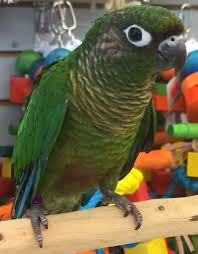Maroon Bellied Conure

Description
The maroon-bellied parakeet (Pyrrhura frontalis) is a small parrot found from southeastern Brazil to north-eastern Argentina, including eastern Paraguay and Uruguay. It is also known as the reddish-bellied parakeet, and in aviculture it is usually referred to as the maroon-bellied conure, reddish-bellied conure or brown-eared conure.
It has been suggested that the reddish-bellied parakeet should include the blaze-winged parakeet (P. devillei) as a subspecies based on intermediate specimens from Paraguay. But such hybrids are not common in the wild and the two populations generally maintain their integrity; recent sources are undecided on whether to treat them as one species or two.
These birds range from 25 to 28 cm (10–11 in), and are primarily green, with a maroon patch on the belly, a "scaly" yellow-green-barred breast and sides of neck, a whitish ear-patch often tinged brown, and a maroon undertail. The specific name frontalis is a reference to its dark maroon frontlet - a feature which separates it from most similar species. The primaries are blue on the outer webs, green on the inner webs, and dark on the tips. The beak is black.
There are two subspecies, with extensive intergradation where their ranges contact:
- Maroon-bellied parakeet proper, Pyrrhura frontalis frontalis – Brazil from south Bahia to Rio Grande do Sul, and west to Mato Grosso do Sul.
Uppertail greenish-yellow grading into a broad reddish tip.
- Azara's conure, Pyrrhura frontalis chiripepe – Eastern Paraguay, Argentina, Uruguay, and far southern Brazil.
Uppertail entirely greenish-yellow.
Another subspecies, kriegi, was described from Bahia in 1932, but today it is universally considered a junior synonym of the nominate subspecies. Distinguished by a narrow brownish-red tip to the tail, it constitutes just a morph or an intermediate genotype making up just 20% of the specimens even in the supposed range. The name Krieg's conure is occasionally used in aviculture for such birds, and some breed them exclusively; they are of course perfectly interfertile with individuals of the normal morph however.
Scientific Name
Pyrrhura Frontalis
Country Of Origin
Size
Life Expectancy
Noise Level
Moderate
Talk / Trick Ability
Fair
Characteristics
Considered one of the more friendly conures, the maroon-bellied conure is also fairly even-tempered and quiet. The maroon-bellied conure is unlike other conures because of its lower noise level. Once owners get to know their maroon-bellied conure, they often find them to be playful and affectionate. In an attempt to grab the attention of their owners, these pet birds will hop and flip around happily. Maroon-bellied conures are known to have spunk and curiosity, and they usually form a bond with the entire family – not just an individual. Socializing a maroon-bellied conure early on and avoiding a dramatic reaction when the bird nips will reduce its tendency to continue a biting habit.
Behavior / Health Concerns
These busy pet birds need plenty of entertainment and interaction. Keeping maroon-bellied conures busy with toys such as swings, spirals and noisemakers will please these high-energy birds. Enclosures, such as play huts, make good accessories because maroon bellies like to playfully hide inside, poking their head out occasionally. Keep a close eye on a Maroon-bellied Conure is important due to their high-energy, which can get them into dangerous situations. In the wild, these birds live in flocks containing several hundred birds and in captivity they do well with breeding. Feather picking and susceptibility to psittacine diseases are difficulties owners may encounter with this pet bird.
Expert Advice
“A little quieter than the Aratinga conures; intelligent, very cute, great birds.”
Liz Wilson, CVT, CPBC